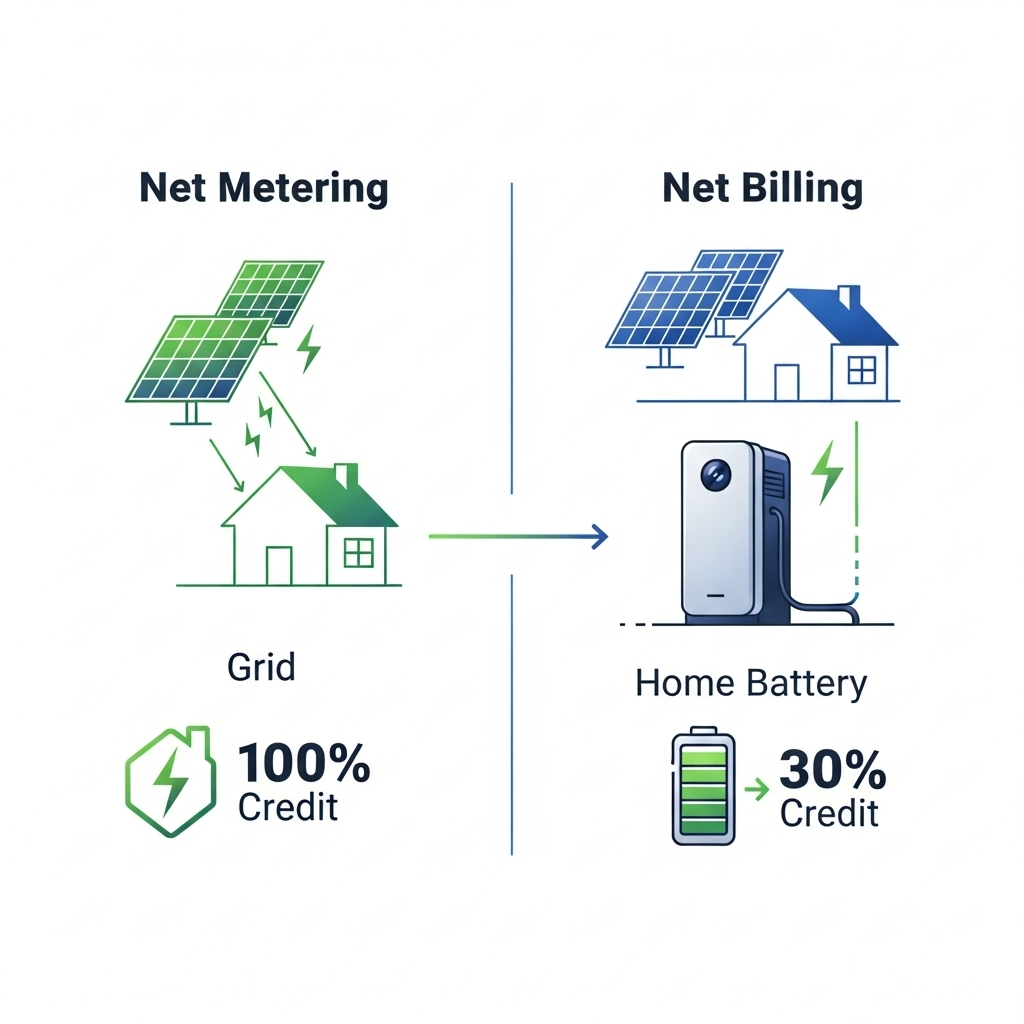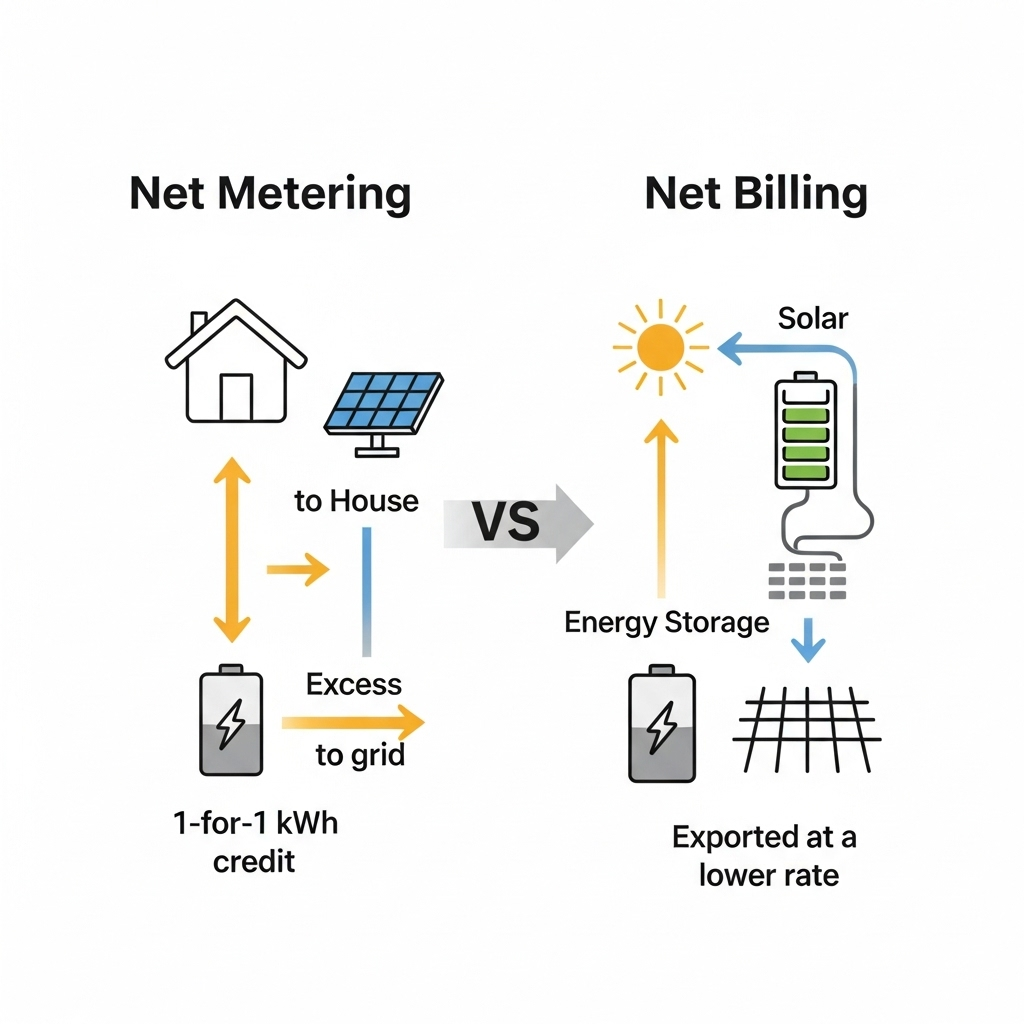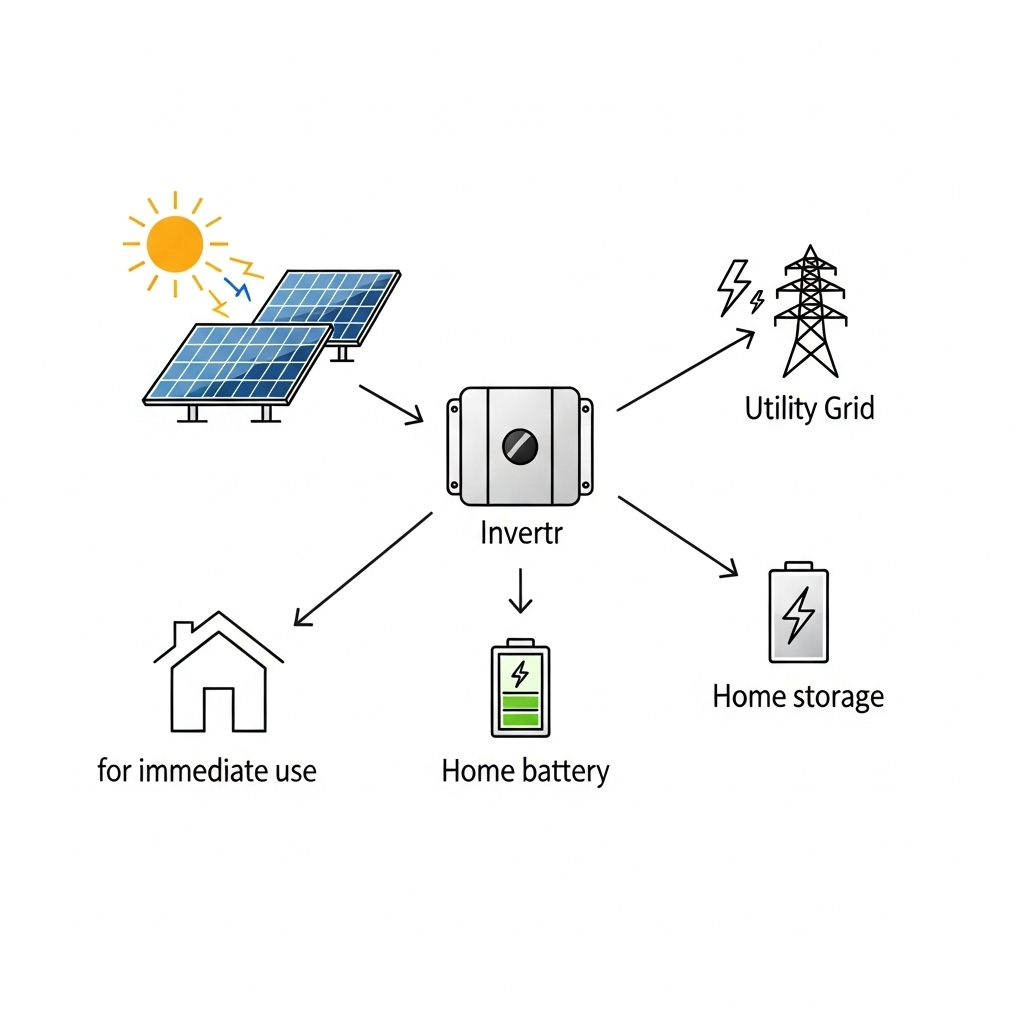Choosing to install a solar panel system is a major step toward energy independence. A critical factor that shapes the financial outcome of your investment is how your local utility compensates you for the excess energy you send to the grid. The two most common policies are net metering and net billing. While they sound similar, they have profoundly different impacts on how you should size your energy storage system (ESS) and the return on investment (ROI) you can expect.
Understanding Solar Export Compensation Models
When your solar panels produce more electricity than your home is using, that surplus energy flows back to the grid. Export compensation rules determine the value of that energy. Let's break down the two main frameworks.
What is Net Metering?
Net metering is a straightforward billing mechanism. For every kilowatt-hour (kWh) of electricity you export to the grid, you receive a credit equal to the full retail value of a kWh. In essence, the utility credits you at the same rate they charge you. This allows you to 'bank' energy credits during sunny days to offset your energy costs at night or on cloudy days. The grid effectively acts as a massive, free battery, simplifying the financial equation for solar owners.
What is Net Billing?
Net billing, sometimes called a 'buy-all, sell-all' or feed-in tariff approach, is a more complex transaction. Under this model, you still buy all the electricity you consume from the grid at the standard retail rate. However, when you export excess solar energy, the utility buys it from you at a different, typically lower, rate. This export rate might be based on the wholesale price of electricity, the utility's 'avoided cost', or another calculated value. This means the energy you export is worth less than the energy you import.
The Critical Role of Energy Storage Under Different Policies
The choice between net metering and net billing fundamentally changes the financial role of a home battery. An energy storage system, which integrates high-performance LiFePO4 batteries with an inverter, gives you control over your solar energy.
ESS Strategy with Net Metering
Under a 1:1 net metering policy, the financial incentive to install a large battery for daily use is minimal. Since the grid gives you full credit for your exported energy, there's no economic penalty for sending it away and drawing it back later. In this scenario, the primary function of an ESS is to provide backup power during grid outages. Therefore, the battery is typically sized to cover only critical loads—like refrigerators, lights, and medical equipment—for a specific duration.
ESS Strategy with Net Billing
Net billing completely changes the game. Because you are paid less for the energy you export, your top priority becomes maximizing self-consumption. Instead of selling your valuable solar energy for pennies on the dollar, you can store it in your own battery. You then use that stored energy during the evening or other times when your panels aren't producing. This strategy, known as energy arbitrage, allows you to avoid buying expensive electricity from the grid. The battery transforms from a simple backup device into an active financial tool that directly increases your daily savings.
How Compensation Rules Dictate ESS Sizing and ROI
Your local export compensation rules are the most significant factor influencing the optimal design and financial payback of your solar-plus-storage system.
Sizing Your ESS for Maximum ROI
With net billing, the goal is to size your battery to absorb most of your typical daily excess solar generation. You want a capacity large enough to power your home through the evening and night, minimizing your reliance on the grid. A system that is too small will still force you to export energy at a low rate, while a system that is too large may not be fully utilized, extending its payback period. In contrast, with net metering, a smaller battery sized for critical backup is often the most cost-effective choice.
| Feature | Sizing Under Net Metering | Sizing Under Net Billing |
|---|---|---|
| Primary Goal | Backup Power During Outages | Maximize Self-Consumption & Daily Savings |
| Optimal ESS Size | Smaller; sized for critical loads (e.g., 3-5 kWh) | Larger; sized to absorb daily excess solar generation (e.g., 10-20 kWh) |
| Financial Driver | Avoids losses during blackouts (peace of mind) | Avoids buying expensive grid power (direct ROI) |
Calculating Your Return on Investment (ROI)
Under net metering, the ROI for a solar system is calculated based on the total energy produced and the retail electricity rate. The battery's ROI is less direct, often measured by the value of uninterrupted power during an outage. With net billing, the battery's ROI is much clearer. Its value is the sum of all the expensive grid electricity you *avoid* buying because you used your own stored solar energy instead. This makes the battery an active contributor to shortening the overall system's payback period. According to research from the International Energy Agency, policies that encourage self-consumption help both the consumer and the grid, as seen in markets like India where it can reduce strain on distribution companies (DISCOMs).
Performance Metrics to Watch
To accurately calculate ROI in a net billing environment, you must account for the real-world performance of your battery. Key metrics like Depth of Discharge (DoD), which is the percentage of the battery's capacity that is used, and round-trip efficiency are vital. Round-trip efficiency measures how much energy you get out for every unit of energy you put in. For example, a battery with 90% round-trip efficiency will provide 9 kWh of usable energy for every 10 kWh used to charge it. A deeper understanding of these factors is crucial, and you can find a complete breakdown in this ultimate reference on solar storage performance.
The Global Trend and Future Outlook
Many regions and countries are gradually shifting away from traditional net metering. A report from the IEA, Integrating Solar and Wind, notes that net metering can lead to an unfair distribution of grid maintenance costs, shifting the burden to non-generating users who are often in lower-income brackets. As a result, policies are evolving. For instance, Brazil's ANEEL has moved from a generous net metering scheme toward a net billing framework to create a more balanced system. This global trend highlights the growing importance of self-consumption. For homeowners, integrating an ESS is the most effective strategy to adapt to these policy changes and protect the financial value of their solar investment.
Making the Right Choice for Your Home
The debate is not about whether net metering is superior to net billing, but rather about understanding the policy in your specific location. Your local utility's rules will be the primary guide for designing a solar-plus-storage system that delivers the best financial outcome. By pairing solar panels with a properly sized energy storage system, you can secure your energy independence and maximize your savings, regardless of the compensation structure. Always consult with a qualified solar installer who understands your local regulations to design a system tailored to your needs.
Disclaimer: This information is for educational purposes only and does not constitute financial or legal advice. Consult with a qualified professional before making any investment decisions.
Frequently Asked Questions
Does a battery make financial sense with net metering?
Under a 1:1 net metering policy, a battery's primary value is for backup power during grid outages, not daily financial savings. The ROI is based on the value you place on having uninterrupted power. For daily savings, the grid itself acts as a 'virtual battery' with full retail credits.
How large of a battery do I need for net billing?
For net billing, the ideal battery size depends on your daily electricity usage and your solar system's production. A good starting point is to analyze your utility bills to find your average daily consumption and size the battery to cover your evening and nighttime usage by storing your excess daytime solar energy.
Will net billing replace net metering everywhere?
Many markets are transitioning toward net billing or other compensation mechanisms that more accurately reflect the value of solar energy to the grid. While the pace of change varies, the global trend is moving away from 1:1 net metering to encourage self-consumption and ensure fairer grid cost allocation.
Can I switch from net metering to net billing?
This depends entirely on your utility and state regulations. Some customers may be grandfathered into existing net metering programs for a set period. If policies change, new solar customers will typically fall under the new rules. Check with your local utility for specific details.





Leave a comment
All comments are moderated before being published.
This site is protected by hCaptcha and the hCaptcha Privacy Policy and Terms of Service apply.